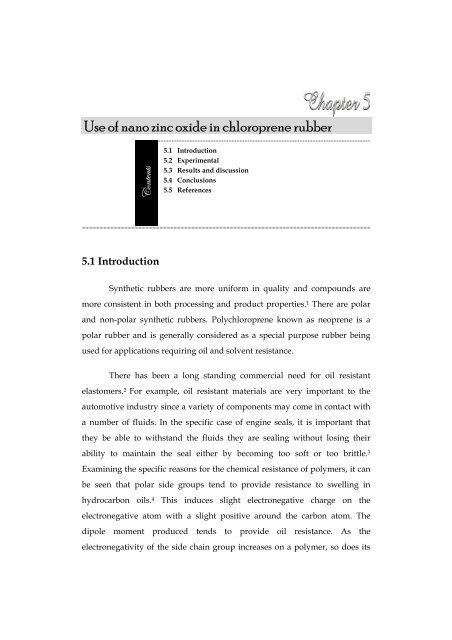Studies on the use of nano zinc oxide and modified silica in NR, CR ...
Studies on the use of nano zinc oxide and modified silica in NR, CR ...
Studies on the use of nano zinc oxide and modified silica in NR, CR ...
You also want an ePaper? Increase the reach of your titles
YUMPU automatically turns print PDFs into web optimized ePapers that Google loves.
Use <strong>of</strong> <strong>nano</strong> <strong>z<strong>in</strong>c</strong> <strong>oxide</strong> <strong>in</strong> chloroprene rubber<br />
VÉÇàxÇàá<br />
5.1 Introducti<strong>on</strong><br />
5.1 Introducti<strong>on</strong><br />
5.2 Experimental<br />
5.3 Results <strong>and</strong> discussi<strong>on</strong><br />
5.4 C<strong>on</strong>clusi<strong>on</strong>s<br />
5.5 References<br />
Syn<strong>the</strong>tic rubbers are more uniform <strong>in</strong> quality <strong>and</strong> compounds are<br />
more c<strong>on</strong>sistent <strong>in</strong> both process<strong>in</strong>g <strong>and</strong> product properties. 1 There are polar<br />
<strong>and</strong> n<strong>on</strong>-polar syn<strong>the</strong>tic rubbers. Polychloroprene known as neoprene is a<br />
polar rubber <strong>and</strong> is generally c<strong>on</strong>sidered as a special purpose rubber be<strong>in</strong>g<br />
<strong>use</strong>d for applicati<strong>on</strong>s requir<strong>in</strong>g oil <strong>and</strong> solvent resistance.<br />
There has been a l<strong>on</strong>g st<strong>and</strong><strong>in</strong>g commercial need for oil resistant<br />
elastomers. 2 For example, oil resistant materials are very important to <strong>the</strong><br />
automotive <strong>in</strong>dustry s<strong>in</strong>ce a variety <strong>of</strong> comp<strong>on</strong>ents may come <strong>in</strong> c<strong>on</strong>tact with<br />
a number <strong>of</strong> fluids. In <strong>the</strong> specific case <strong>of</strong> eng<strong>in</strong>e seals, it is important that<br />
<strong>the</strong>y be able to withst<strong>and</strong> <strong>the</strong> fluids <strong>the</strong>y are seal<strong>in</strong>g without los<strong>in</strong>g <strong>the</strong>ir<br />
ability to ma<strong>in</strong>ta<strong>in</strong> <strong>the</strong> seal ei<strong>the</strong>r by becom<strong>in</strong>g too s<strong>of</strong>t or too brittle. 3<br />
Exam<strong>in</strong><strong>in</strong>g <strong>the</strong> specific reas<strong>on</strong>s for <strong>the</strong> chemical resistance <strong>of</strong> polymers, it can<br />
be seen that polar side groups tend to provide resistance to swell<strong>in</strong>g <strong>in</strong><br />
hydrocarb<strong>on</strong> oils. 4 This <strong>in</strong>duces slight electr<strong>on</strong>egative charge <strong>on</strong> <strong>the</strong><br />
electr<strong>on</strong>egative atom with a slight positive around <strong>the</strong> carb<strong>on</strong> atom. The<br />
dipole moment produced tends to provide oil resistance. As <strong>the</strong><br />
electr<strong>on</strong>egativity <strong>of</strong> <strong>the</strong> side cha<strong>in</strong> group <strong>in</strong>creases <strong>on</strong> a polymer, so does its

















